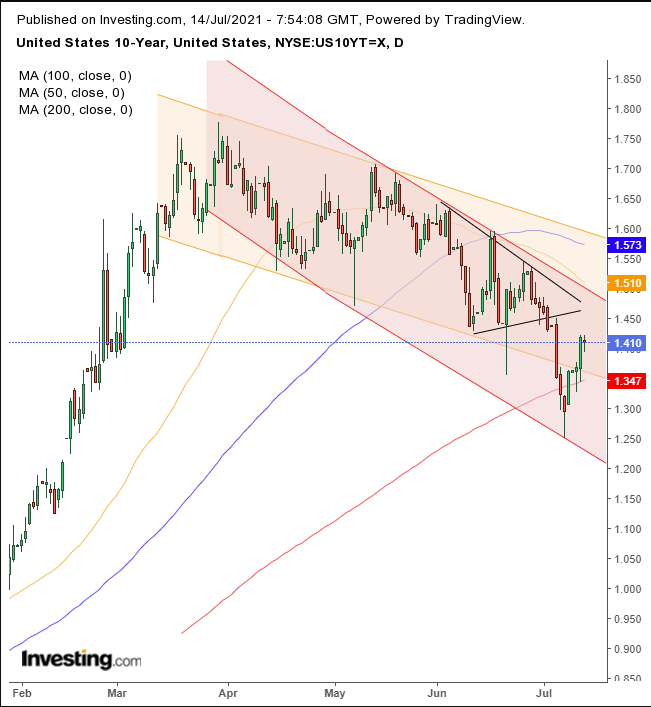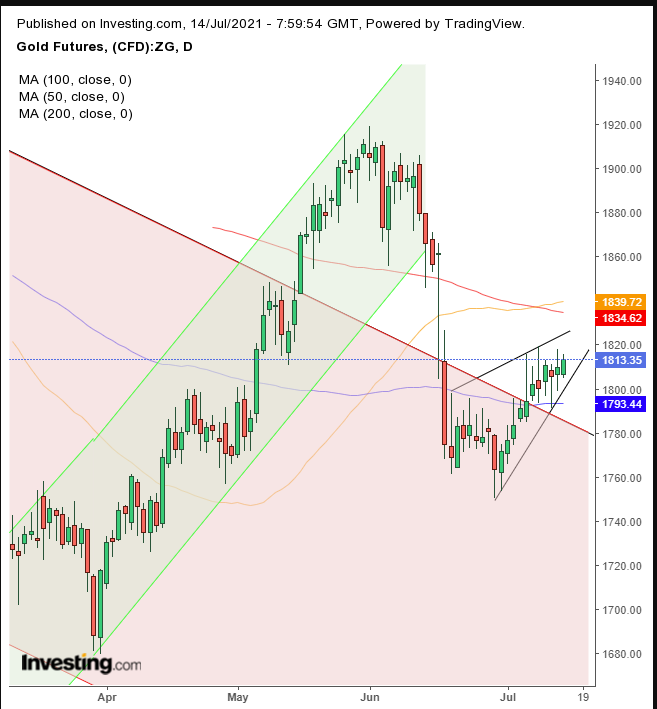- US inflation surged even more than expected
- Yields slide further
- Gold rises for the second day
Key Events
US futures on the Dow, S&P, NASDAQ and Russell 2000 were pointing to a marginally higher US open in trading on Wednesday after higher than expected inflation figures surprised investors yesterday and saw markets close lower. European shares were lower.
Analysts think the recent surge in CPI is consistent with inflation being "transitory" and cooling later this year.
The price of oil has dropped; the dollar is lower.
Global Financial Affairs
The highest inflation increase since 2008 surprised traders, driving the major indices lower yesterday. Mixed results from US megabanks JPMorgan Chase (NYSE:JPM) and Goldman Sachs (NYSE:GS) saw their share prices slide. The investment banking divisions in both banks posted strong gains, but trading revenue fell as the boom in trading in Q1, when volatility increased due to the global coronavirus pandemic, subsided.
There is also some concern about the impact weaker yields may have on future profit growth. To date, the business of banking hasn't yet caught up with rising inflation, such expansion could materialize only when the Fed actually tightens ultraloose accommodations.
To clarify, we're making a distinction between the movement in share prices, which is determined by technical supply and demand, and actual profits from the banks’ business segments—the fundamentals. Today, additional giant US financial institutions due to release results include Bank of America (NYSE:BAC), Wells Fargo (NYSE:WFC) and Citigroup (NYSE:C). We will be watching these reports for affirmation of our observation.
The STOXX 600 Index was weighed down by travel and leisure firms amid the ongoing spread of the Delta variant of COVID-19 which is putting a brake on hopes of an economic recovery led by cyclicals.
Yields on the 10-year Treasury note, watched as a gauge for higher interest rates, retreated to 1.4%.

Rates seem to find resistance approaching a bearish triangle, which was accompanied by a bearish cross of the 50 DMA below the 100 DMA. The 200 DMA appears as the last support before the yield resumes its slide along the steepening falling channel.
The dollar was higher yesterday though it's trading lower at time of writing.

Yesterday’s rally in yields pushed the greenback up by the most in almost four weeks; it's edging towards the Mar. 31 high. If the dollar climbs above that it would have completed a double bottom.
Irrespective of the greenback, gold climbed for the second day. It isn’t clear how rising inflation will affect gold prices. On the face of it, the precious metal is an inflation hedge, but if the Fed again moves the timeline to higher rates, it could benefit the dollar, at the expense of gold.
The yellow metal's recent climb does not seem to be as a result of its inflation hedge status, as silver and copper were mostly flat, and investors increased their Treasury holdings—all things which don’t fit the inflation narrative.

Gold appears to be developing a rising wedge on the top of its falling channel and below a Death Cross.
Bitcoin fell for the third day.
Oil was lower after nearing its highest level in over 2.5 years on the outlook for a tightening market. China has also started to slow its oil buying which could weaken the price further.
Up Ahead
- The Bank of Korea announces its monetary decision Thursday.
- On Thursday, China reports second-quarter GDP.
- On Friday, Bank of Japan interest rate decision Friday
Market Moves
Stocks
- Futures on the S&P 500 fell 0.2%
- Futures on the NASDAQ 100 were little changed
- Futures on the Dow Jones Industrial Average fell 0.2%
- The STOXX 600 fell 0.2%
- The MSCI World index fell 0.1%
Currencies
- The Dollar Index fell 0.1%
- The euro was little changed at $1.1786
- The British pound rose 0.2% to $1.3835
- The Japanese yen rose 0.1% to 110.50 per dollar
Bonds
- The yield on 10-year Treasuries declined two basis points to 1.40%
- Germany’s 10-year yield advanced one basis point to -0.28%
- Britain’s 10-year yield advanced three basis points to 0.66%
Commodities
- West Texas Intermediate crude fell 0.2% to $75.10 a barrel
- Gold futures rose 0.1% to $1,812.60 an ounce
